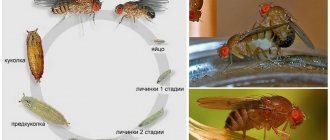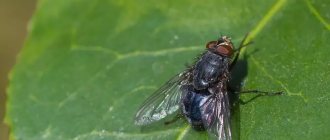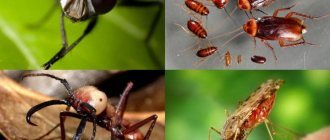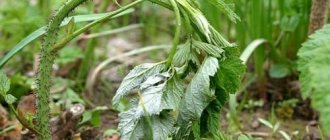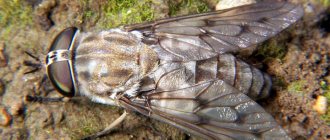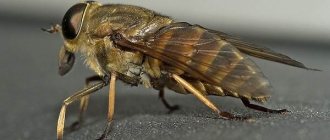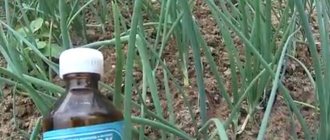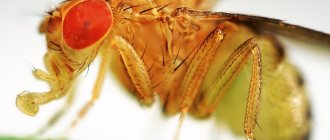Order Diptera (Diptera)
Mosquitoes. Butterflies. flies
rice. 1. Scheme of the structure of the oral apparatus of the piercing-sucking Culex mosquito: 1 - mandibular palps, 2 - upper lip, 3 - upper jaw, 4 - lower jaw, 5 - hypopharynx, 6 - lower lip.
They have one pair of wings, the second pair is transformed into halteres (presumably an organ of balance). Head with large compound eyes on the sides. Mouthparts of the piercing-sucking or licking type. The chest segments are fused together. Adults can only absorb food in liquid form; among dipterans there are many blood-sucking species, and there are species that feed on nectar. Development with complete transformation. The larvae are worm-shaped, without legs; flies have no heads. The larvae develop in water, rotting substrates, animal and plant tissues, and soil.
The order Diptera is divided into suborders: Long-whiskered (Nematocera), Short-whiskered straight-stitched (Brachycera-Orthorrhapha), Short-whiskered round-stitched (Brachycera-Cyclorrhapha).
Representatives of the suborder Longwhiskers have long multi-segmented antennae, a larva with a head capsule and a covered pupa. Covered pupae are those in which the rudiments grow tightly to the body. The suborder Longwhiskers is divided into families: True mosquitoes (Culicidae), Butterflies (Psychodidae), etc.
rice. 2. Distinctive features of the malarial and common mosquitoes: 1 - “floats”, 2 - respiratory openings, 3 - palm-shaped hairs, 4 - respiratory siphon of the larva, 5 - respiratory siphon of the pupae, 6 - abdomen, 7 - mandibular palps.
True mosquitoes (Culicidae) usually hide in vegetation and indoors during the day, and at night they attack vertebrates, in particular humans, on whose blood they feed. Only female mosquitoes suck blood. In our region, the common mosquito of the genus Culex and the malaria mosquito of the genus Anopheles are often found. These mosquitoes lay their eggs in water. Larvae and pupae also develop in water. The Anopheles mosquito is called an anopheles mosquito because it transmits Plasmodium parasites. Differences between the malaria mosquito and the common mosquito are present at all stages of the life cycle (Fig. 2, 3).
The female malaria mosquito lays eggs singly, without sticking them to each other. The eggs have air “floats” and float on the surface of the water. The eggs of the malaria mosquito hatch into larvae that do not have a respiratory siphon; therefore, to breathe, the larva lies parallel to the surface of the water, pressing the respiratory openings against it.
The larvae of mosquitoes of the genus Culex have a respiratory siphon at the end of the abdomen, so they are positioned at an angle to the surface of the water to breathe.
Mosquito pupae also breathe atmospheric air; respiratory siphons are located on the cephalothorax. The respiratory siphon of the malaria mosquito pupa has the shape of a funnel, while the siphon of the common mosquito pupa has the shape of a tube.
rice. 3. Heads of malarial and common mosquitoes: A - female Culex, B - female Anopheles, C - male Culex, D - male Anopheles: 1 - proboscis, 2 - antennae, 3 - palps.
When landing, the abdomen of a malaria mosquito is at an angle to the surface, while that of an ordinary mosquito is parallel to the surface. The palps of the female malaria mosquito are equal in length to the proboscis. The palps of the female Culex mosquito are several times shorter than the proboscis. The palps of the male analaria mosquito are equal in length to the proboscis and have club-shaped thickenings. The palps of the male Culex mosquito are also equal in length to the proboscis, but do not have club-shaped thickenings.
Mosquitoes of the genus Culex can carry pathogens of Japanese encephalitis and yellow fever.
Butterflies (Psychodidae) are small dipterans with fluffy wings that have dense veining. This family includes mosquitoes of the genus Phlebotomus, which carry the pathogens of papatachi fever, cutaneous leishmaniasis, and visceral leishmaniasis (Fig. 4).
rice. 4. Mosquito (Phlebotomus sp.)
rice. 5. Tsetse fly (Glossina palpalis)
Representatives of the suborder Short-segmented round-stitched have very short three-segmented antennae with setae on the third segment. In larvae, the head capsule is reduced and only oral stylets are present. The pupa is free, located in the puparia - a shell made of unshed larval skin. When the fly emerges, the puparia opens along a rounded line, hence the name of the suborder. The suborder Short-whiskered round-stitched flies is divided into families: True flies (Muscidae), Gray blowflies (Sarcophagidae), Subcutaneous flies (Hypodermatidae), Stomach flies (Gastrophilidae), etc.
Among the representatives of the family True flies (Muscidae) there are many synanthropic species. The housefly (Musca domestica) is often found in cities. Its larvae develop in sewage, manure, garbage and garbage pits. Housefly larvae have extraintestinal digestion. Adults pose a danger to humans because they are mechanical carriers of bacterial spores, helminth eggs, and protozoan cysts (Fig. 6, 7).
rice. 6. Housefly: A - eggs, B, C - larvae of different ages, D - puparium, E - pupa extracted from the puparium, E - imago.
Blood-sucking representatives of this family include the tsetse fly (Glossina palpalis), which carries trypanosomes, the causative agents of human sleeping sickness in Africa (Fig. 5).
The Wohlfart fly (Wohlfahrtia magnifica) belongs to the Gray blowfly family. Found in the southern regions of Russia. Adults feed on nectar and plant sap. Females are viviparous. Up to 100 larvae are deposited simultaneously on the skin and mucous membranes of animals. There are known cases of larvae being deposited in the ears, wounds, nose, and eyes of a sleeping person. The larvae penetrate deep into tissues, destroying them mechanically and with enzymes. Tissue myiasis develops. The larvae can eat away soft tissue to the bone. 3–5 days after infection, the larvae fall out and pupate in the soil.
rice. 7. Structure of the licking oral apparatus of a housefly: 1 - compound eye, 2 - vibrissae, 3 - base of the proboscis, 4 - lower lip, 5 - labial lobe, 6 - oral opening, 7 - upper lip, 8 - mandibular palps, 9 - antennae.
Gadflies cause great harm to livestock farming. Adult gadflies have an undeveloped mouthparts and do not feed.
Subcutaneous gadflies are dipterans whose larvae develop under the skin of animals. Females (Fig. lay eggs on the fur of animals, the hatched larvae penetrate into the skin, where they develop. Before pupation, they emerge through the fistulas, fall into the soil, where they pupate.
Females (Fig. lay eggs on the fur of animals, the hatched larvae penetrate into the skin, where they develop. Before pupation, they emerge through the fistulas, fall into the soil, where they pupate.
rice. 8. Bovine gadfly (Hypoderma bovis)
Gastric botflies are dipterans whose larvae develop in the gastrointestinal tract of animals. The female gadfly lays eggs on such areas of the skin that the animal can reach with its lips. Eggs or larvae are swallowed by the animal and enter the stomach; here the botfly larvae lead a parasitic lifestyle, feeding on blood and mucus. After development is completed, the larvae pass through the intestines and are released into the environment along with feces. They pupate in the soil.
► Insects with complete metamorphosis (Holometabola) also include the following orders:
- Order Reticulates (Neuroptera)
- Order Coleoptera, or Beetles (Coleoptera)
- Order Hymenoptera (Hymenoptera)
- Order Fleas (Siphonaptera, or Aphaniptera)
- Order Lepidoptera, or Butterflies (Lepidoptera)
- Brief description of the class Insects
- Classification of the class Insects
► Go to the table of contents of the book “Zoology of Invertebrates. Theory. Tasks. Answers"
Squeak mosquito and housefly
When a malaria mosquito sits on something, it raises its abdomen; an ordinary squeaking mosquito holds it parallel to the surface or even lowers it slightly.
The larvae of the squeaking mosquito hang vertically, head down, at the surface of the water, while the larvae of the malaria mosquito hang horizontally.
Both insects are from the family of true mosquitoes, which contains one and a half to two thousand species. From the tundra to the tropics you can find representatives of this family, and everywhere they are the most obnoxious of bloodsuckers. However, not all true mosquitoes suck the blood of animals; many species are content with nectar and plant juice. And among bloodsuckers, only females feed on blood, males only on plant sap.
By autumn, all the male mosquitoes die; only the females overwinter in different crevices. In the spring they awaken and rush to the water. Eggs are laid on its surface, which float in small piles with a diameter of about 7 millimeters, and in each pile there are several hundred eggs. If for some reason the female mosquito was unable to drink blood before laying eggs, then she lays fewer eggs - 40-80.
The larvae hatch soon. They are heavier than water, and in order to stay near the surface, they have to make considerable efforts: twitching and wriggling, they float up and hang upside down from the surface film of water. But as soon as there is any danger, they immediately go down. Then they float up again. They feed on microscopic algae, the remains of dead animals and plants, filtering up to a liter of water each day.
Mosquito larvae (in the middle of the pupa) - hang at the surface of the water
After about three weeks, the mosquito larvae pupate. The pupae are lighter than water and float to the surface on their own. They already have eyes, although they are still hidden under the covers of the pupa. But these covers are transparent, and the sudden illumination frightens the mosquito pupae - they all immediately descend into the depths. But they soon surface again. Pupae do not eat anything: their mouthparts change from filtering to piercing-sucking. Other transformations quickly take place, and after a few days a long-legged winged mosquito emerges from its bursting covers.
On quiet, windless evenings, male mosquitoes gather in flocks: usually they hover over some tree, bush, bell tower, even over a person walking along the road. Turning their heads against the wind, rising and falling rhythmically, the mosquitoes seem to dance in place. The smell that the mosquito's special glands emit during flight intensifies thousands of times when they gather in a flock. Dancing, mosquitoes scatter it in all directions, and, attracted by this smell, females rush to dance from all sides. Sometimes they also gather in a flock, which hovers just below the dancing males. Suddenly, one or the other female breaks out of the flock and flies up into the company of males. A moment, and the united couple falls to the ground.
How does a male find a female so quickly among thousands of mosquitoes randomly scurrying up and down? He hears her! He hears the beating of her wings. They oscillate five hundred times per second, and the male's antennae begin to vibrate in unison with their oscillation. A special organ located in the second antennal segment perceives only the beating of the wings of a sexually mature female. It is the sexually mature one, the immature one flaps its wings in a different rhythm, just like male mosquitoes. Therefore, the mosquito's antennae, tuned to a certain oscillation frequency, do not respond to the flapping of the wings of other males in the flock.
Tsetse fly
The old question: in order to lay mature eggs, whether the females of all mosquitoes must first drink blood, has not been completely resolved. Apparently, for some subspecies of common squeaking mosquitoes this condition is not necessary. And hungry females develop eggs, only the fertility is much less than that of those who have sucked blood.
Housefly. She does not live in the wild, outside towns and cities. Became a human companion. Its larvae develop in all kinds of rotting waste. The fertility and precocity of these flies is amazing. The female lays 100-150 eggs every 2-4 days (5-6 times in total during her life). After about 12 hours or a day, headless larvae emerge from them. After a day and a half they shed for the first time, then again and again. They pupate in less than 10 days. If it is warm, after three days, when it is colder, a day or two later, the pupae turn into an adult fly. Three days after hatching, she already lays eggs.
Thus, one fly generation is able to develop and begin to bear fruit in about two weeks. And it turns out that when the summer is hot, one fly can produce nine generations of its own kind. Let's assume that all of her descendants survived, then their number by the end of summer will exceed 5 trillion! Seventy flies weigh approximately one gram, and the offspring of one fly weigh 80 thousand tons!
A colossal breeding ground for microbes! After all, each fly carries more than 30 million different microorganisms on itself and in itself (in the intestines), many of which are very, very pathogenic.
“They carry the pathogens of lethal sleeping sickness (humans) and nagana (cattle). No other fly has been as well researched as this one... There are about 30 species, and each has its own specific environmental requirements. Some require high, others moderate, air humidity and temperature. Some live in shrub savanna, others in gallery forests growing along river banks, and others in tropical rain forests. The choice of victims is also different: some bite people, others do not. Some drink the blood of large ungulates and livestock, others drink the blood of small mammals, birds, crocodiles and monitor lizards” (Peter Ritschel).
We are talking about flies from the genus Glossina. The famous tsetse fly also belongs to it. She suffers from sleeping sickness. This is a viviparous fly! She incubates the larvae for a week or two. They are born ready to pupate. By this time, the fly is hiding somewhere in a shady place. The larvae burrow and soon pupate. The tsetse fly gives birth to larvae 8-10 times during its life.
